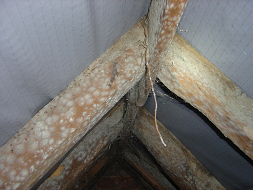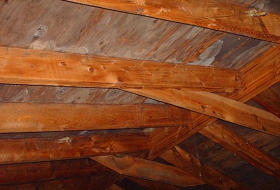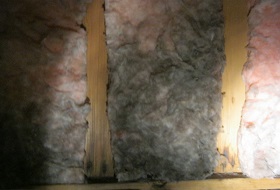Mould in Loft and Roof

Mould can grow in literally any part in the house which has sufficient moisture and nutrient available for the mould to feed on. Because nutrients are always present the only truly limiting factor is the amount of available moisture. Lofts usually get contaminated by mould due to failure in the roof construction which allows water to enter the loft area. The free water then evaporates into the loft space and consequently condenses on the wooden rafters on within the fibreglass insulation. Mould in loft can quickly become a serious problem.
Because lofts are usually not inspected or used on a regular bases the mould loft contamination can become quite serious before it is noticed. Large areas of structural timber can become fully covered by mould carpets. Entering heavily contaminated confided area can result in massive exposure to mould spores and toxin. Such exposure can lead to the onset of mould exposure symptoms almost immediately. When you planning for inspecting you loft for the presence of mould always use respiratory protection.Other causes of mould in the loft area is improper roof construction where builder do not install soffit vents or these vents become coved and block by mineral wool insulation. When the moisture loaded air from internal areas of the house enters the loft space which is usually significantly cooler the water condenses and mould contamination follows.
Moulds or Wood Rotting Fungi

When you discover that your loft is suffering from some sort of fungal contamination it is important to identify whether the contamination is due to surface colonisation by moulds or deep contamination by wet rot fungi or dry rot fungi. Surface contamination of loft by moulds will require specialised mould removal under controlled conditions followed by sterilisation of the whole area. Repairs to the structural failure such as cracked gutter or slipped roof tiles will be obviously required.
If however your loft is contaminated and colonised by wood rotting fungi the matter becomes much more serious form the structural point of view. Wood rotting fungi contamination indicates a deeper problem with the building structure and apart from the removal of the visible fungus extensive repairs and replacement of the roof structure may be required.
Moulds in mineral wool insulation

From the mould point of view the mineral wool insulation provides a perfect habitat for moulds. It is an open structure with almost endless surface area providing more than enough nutrients. When water starts to condensate within the mineral wool insulation mould contamination will always follow. The amount of mould that can grow within the 300-500mm of wool insulation can be quite spectacular. The only feasible way to deal with mould contamination of mineral wool insulation is to dispose of it securely.
